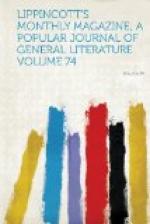Altogether, the scene is picturesque beyond description,—a charming valley, threaded by limpid streams, and dotted with dense forests of oak, pine, poplar, cherry, and walnut, the whole encircled by huge sandstone ridges, their loftier peaks capped by the clouds, and standing there grim, silent, and sublime, like giant sentinels guarding the gates of an earthly paradise. Years afterward, speaking of the scene as it then broke upon him, Robertson said, “It seemed to me the Promised Land.”
As the explorers prepared to descend into the valley, they noticed a few miles away, at the north, a slight smoke curling up from among the trees near the banks of what is now known as Boone’s Creek, a small tributary of the Watauga. Was it from the encampment of some Indian hunter, or the cabin of a white man who had settled there since the visit of Boone, five years before? With the caution of old hunters they descended the mountain and approached the spot whence the smoke issued. It was a log hut, newly built, and around it, in the stacked corn and the cattle browsing near, were evidences of a white inhabitant. He was a former comrade of Boone, his companion during his visit here in 1760, and he had returned during the previous summer and built a home for his family. His name was William Bean, and he was the first white settler west of the Alleghanies.
The explorers were hospitably entertained by Bean and his wife, but, after a few days spent in piloting Robertson about the valley, Boone set out on his first long tramp through Kentucky. Robertson remained behind, and was not long in deciding that he had happened upon the right spot for a settlement. This decided on, he set about making preparations for the incoming settlers. Selecting a spot of fertile soil, he broke it up and planted a crop of corn,—enough to carry the expected colonists through another season,—meanwhile making his home with Bean, the hospitable first settler.
It was autumn before his corn was gathered, and the rainy season had set in when he started to return to North Carolina. He had carefully husbanded his small stock of powder and lead, and with what remained, and enough parched corn and jerked venison to last, with what game he might kill, for ten or more days, he set out on his solitary journey homeward. There soon came on a heavy rain, which drenched him completely, and, worse than this, wet through and through every ounce of his powder. Wrapping his blanket closely about him, he tried to dry the powder with the warmth of his naked flesh; but all his efforts were unavailing: the precious grains had totally lost the power of ignition. Reduced now to his prepared food, he determined to push on with all speed, and, before his supply should be exhausted, reach the settlements on the other side of the mountains.




